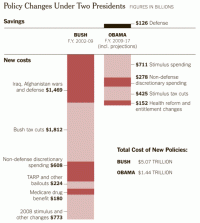 James Fallows of The Atlantic calls it, “The Chart That Should Accompany All Discussions of the Debt Ceiling“:
James Fallows of The Atlantic calls it, “The Chart That Should Accompany All Discussions of the Debt Ceiling“:
It’s based on data from the Congressional Budget Office and the Center on Budget and Policy Priorities. Its significance is not partisan (who’s “to blame” for the deficit) but intellectual. It demonstrates the utter incoherence of being very concerned about a structural federal deficit but ruling out of consideration the policy that was largest single contributor to that deficit, namely the Bush-era tax cuts.
An additional significance of the chart: it identifies policy changes, the things over which Congress and Administration have some control, as opposed to largely external shocks — like the repercussions of the 9/11 attacks or the deep worldwide recession following the 2008 financial crisis. Those external events make a big difference in the deficit, and they are the major reason why deficits have increased faster in absolute terms during Obama’s first two years than during the last two under Bush. (In a recession, tax revenues plunge, and government spending goes up – partly because of automatic programs like unemployment insurance, and partly in a deliberate attempt to keep the recession from getting worse.) If you want, you could even put the spending for wars in Iraq and Afghanistan in this category: those were policy choices, but right or wrong they came in response to an external shock.
